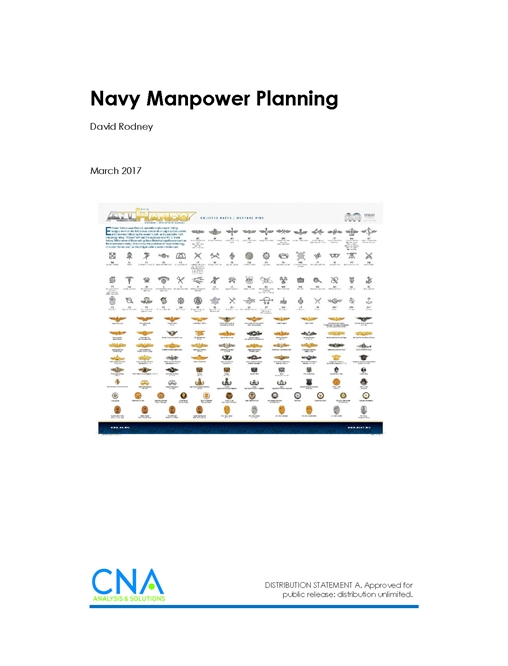Navy manpower planning is the process by which the Navy and other branches of government endeavor to provide the personnel necessary to man the fleet. It is a rich and complex topic that has a large body of institutional knowledge and a large body of prior research. It is a multidisciplinary subject, and there are many complicated long-standing problems.
Gaining an understanding of Navy manpower planning is not easy: there’s a lot to learn and no standard texts. Moreover, knowledge is diffuse and not captured in one place. The goal of this document is to provide an overview of the process. The target audience is anyone who wants a broad understanding of Navy manpower planning—for example, someone moving into a leadership position in the management of Navy personnel. We also point people in the right direction to obtain further information on the many intricacies and issues. We leave out many details because we don’t want to obscure a main message in a forest of details. We are aiming to be “roughly right” and convey the big ideas and key information. We apologize for any resulting lack of precision.
Navy manpower planning has been described as “getting the right person to the right place at the right time.” This simple statement addresses the layers of complexity that apply to the management of Navy military personnel. An example provides some insights.
Consider the task of ensuring that the Navy has an ample supply of proficient destroyer commanding officers in the year 2017. For this to happen, an extensive sequence of events must have occurred over many years:
- The Navy recruited sufficient surface warfare officers at the beginning of the 21st century.
- The Navy provided career development to these officers.
- The Navy retained enough high-quality officers to provide a good “quality cut” for selection of officers for career advancement.
- The promotion of officers in each cohort met legal and policy guidelines.
- The personnel distribution system selected excellent officers to fill the commanding officer billets when the vacancies for these assignments arose.
Each of these events is complicated and also needs to be consistent with the other events. Moreover, multiyear planning inevitably involves a lot of uncertainty and trade-offs between short- and long-term considerations. Hence, the successful management of this task requires a lot of understanding of many personnel management issues and how they work together. The purpose of this monograph is to help provide such an understanding.
Navy personnel management focuses on several categories of personnel: active duty personnel, reserves, civil servants, and contractors. Different considerations (legislation, policies, objectives, personnel management objectives, etc.) apply to each personnel category. This monograph focuses on active duty personnel, who are the primary concern of Navy management.
Download reportDISTRIBUTION STATEMENT A. Approved for public release: distribution unlimited. 2/28/2017
Details
- Pages: 111
- Document Number: CPP-2017-U-015038-Final
- Publication Date: 3/15/2017
